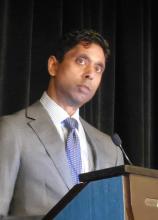The Society for Cardiovascular Angiography and Interventions (SCAI) has refined its cardiogenic shock (CS) classification system based on the literature and clinician feedback from real-world experience.
“In the 2 years since publication in 2019, the initial definition has been broadly accepted and eagerly appreciated, allowing a very intuitive way to stage these patients for better communication, triage, and treatment,” Srihari S. Naidu, MD, professor of medicine, New York Medical College, Valhalla, said in an interview.
“But the initial definition was based on consensus opinion, with a lack of real fundamental data on segregating patients into different stages. Now we have a lot more data utilizing the definition, and it became very clear that there were a couple of limitations in the initial definition,” Dr. Naidu explained.
The refined CS classification system – authored by Dr. Naidu and a multidisciplinary panel of experts from specialties that included cardiac critical care, interventional cardiology, surgery, nursing, emergency medicine, and heart failure – was published online Jan. 31 in the Journal of the Society for Cardiovascular Angiography and Interventions, with simultaneous publication in the Journal of the American College of Cardiology.
It maintains the five-stage pyramid of CS, starting with “at risk” and moving through “beginning,” “classic,” “deteriorating,” and “extremis” but now includes gradations of severity within each stage and pathways by which patients progress or recover.
“Progression across the SCAI shock stage continuum is a dynamic process, incorporating new information as available, and patient trajectories are important both for communication among clinicians and for decisionmaking regarding the next level of care and therapeutics,” the panel writes.
The second iteration adds a streamlined table incorporating commonly seen variables, based on lessons learned from validation studies and clinician experience.
“While keeping the same initial framework of looking at the three components of staging – the physical exam, the biochemical markers, and hemodynamics – we’ve made it very clear that there are some factors in each of these that are most typically seen. And then there are other factors that are consistent with that stage but don’t necessarily have to be seen, ... are not typically seen in that stage, or [are] not always present at that stage,” Dr. Naidu told this news organization.
The refined CS classification system provides more granularity on cardiac arrest as a risk modifier, which now excludes very brief episodes with rapid response to defibrillation and comprises only those patients who have impaired mental status with unknown neurologic recovery status after cardiopulmonary resuscitation.
Lactate level and thresholds have been highlighted to detect hypoperfusion but may be dissociated from hemodynamics in cases such as chronic heart failure.
In addition, patients may have other manifestations of end-organ hypoperfusion with a normal lactate level, and there are also important causes of an elevated lactate level other than shock.
The revision proposes a three-axis model of CS evaluation and prognostication that integrates shock severity, clinical phenotype, and risk modifiers as distinct elements that should be applied to individualize patient management.
The revision also places more emphasis on the trajectory of the patient with CS through hospitalization, including a “hub and spoke” model for transfer of higher-risk patients, including those with a deteriorating SCAI shock stage.
“It is our desire and belief that the revised SCAI SHOCK stage classification system will enhance both clinical care and CS research trial design,” the panel writes.
This statement has been endorsed by the American College of Cardiology, American College of Emergency Physicians, American Heart Association, European Society of Cardiology Association for Acute Cardiovascular Care, International Society for Heart and Lung Transplantation, Society of Critical Care Medicine, and Society of Thoracic Surgeons.
This research had no commercial funding. Dr. Naidu has disclosed no relevant financial relationships. A complete list of author disclosures is available with the original article.
A version of this article first appeared on Medscape.com.


